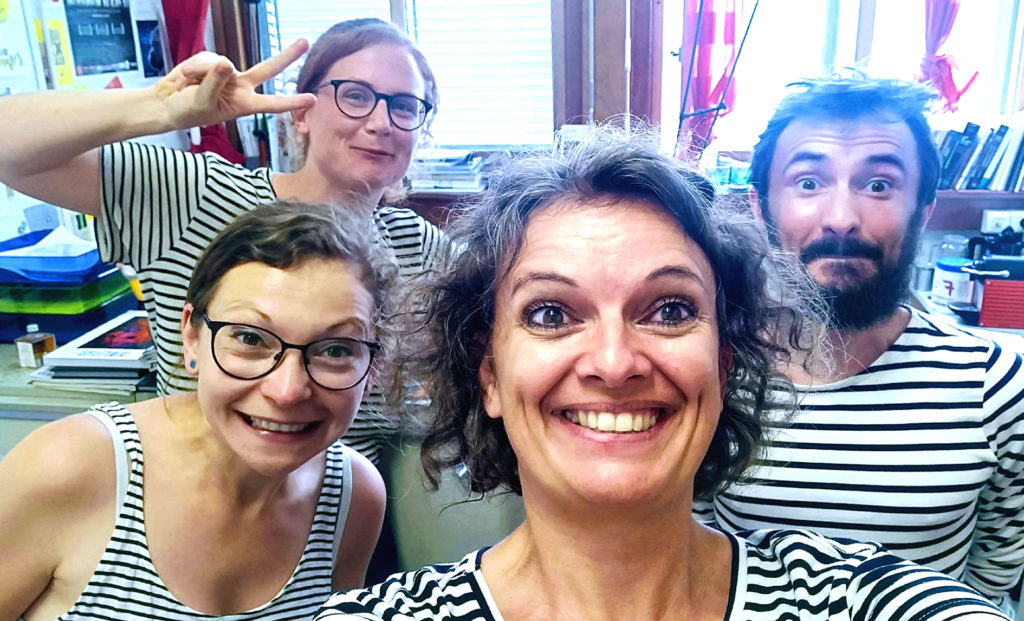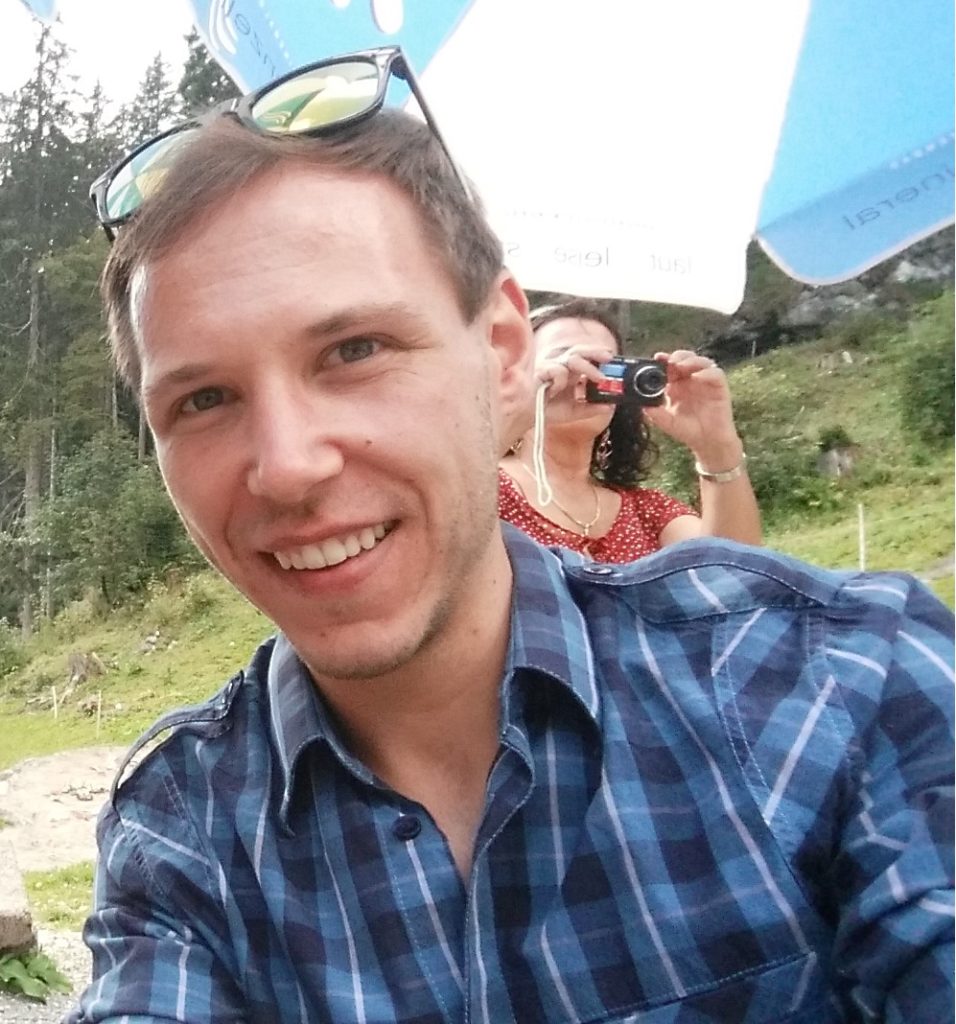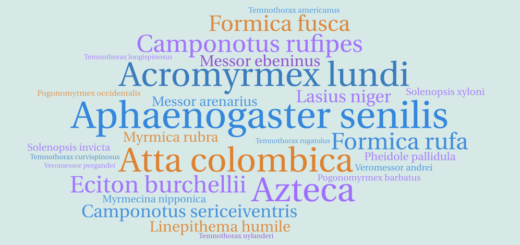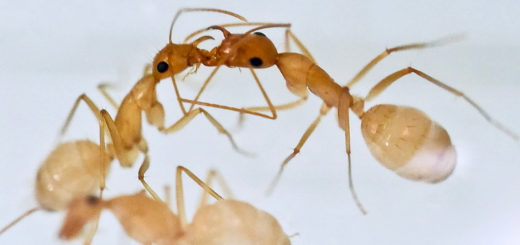Interview with Audrey Dussutour

Audrey Dussutour is a senior researcher and works at the CNRS at the University Paul Sabatier in Toulouse. She studies ants and slime moulds and is involved in science communication. Here, we talk about a recently published review paper on ant nutrition, about her career, and why ants and slime
An Interview compiled by Patrick Krapf

MNB: Could you just tell us briefly about your review which is going to be published soon in Myrmecological News?
AD: Yes, the paper we wrote with Enikő is a review paper. The aim of this paper was to review what we knew so far about ant nutrition, a subject that I have been studying for a very long time now, I think since 2006. At the beginning of my career, I was studying collective behaviour in ants, and especially how ants deal with traffic jams. When I moved to Sydney as a PostDoc, I started to study collective nutrition in ants. During my PhD in France, I studied foraging behavior but in Sydney, I decided to focus my investigations on the type of food the ants are collecting. I applied for the first time in a social insect a new approach for studying nutrition called geometric framework. Since then, many people used the same approach to study ant nutrition and a review seemed timely. We reviewed and discussed all studies that have applied nutritional geometry to study ants’ nutrition. We also proposed new experiments to do in the future using the same approach. It is an approach that I have been using also on slime moulds, Drosophila, and many other species now, but mostly on ants. It is a very powerful approach that can appear a little bit complicated. So, in the review, we introduced the framework first and explained how we can use it to better understand ants’ nutrition.
MNB: Sounds interesting. Could you briefly explain what geometric nutrition is?
AD: Ant colonies, and even individuals within colonies have their own specific nutritional requirements in terms of the amount and ratio of nutrients. These requirements may vary according depending on the performance index we are focusing on (longevity, reproductive success, immune response…etc). Nutritional geometry is an approach, which can be used to understand how an animal meets its nutritional requirements in an environment where multiple foods of varying nutritional composition are available. Nutritional geometry focuses on mixtures of nutrients and their interaction and not on foods alone or on individual nutrients. It is a state‐space-modelling platform in which food intake and nutritional state of individuals can be represented in a nutritional space where each axis represents key food components such as macronutrients.
MNB: How did you come up with this idea to create a review paper?
AD: I was invited to write this review for a long time now. You know writing a review takes a lot of time, and sometimes you prefer to prioritize experimental papers. When Enikő joined me as a PostDoc, I thought it was a good idea to write this review together because she was new in the field of nutrition, and she needed to read all these papers anyway. So, this was a perfect opportunity to actually write this review. It was also good because many people were asking for this review.
MNB: And did you have any obstacle in finding papers or was it clear which papers you had to read for the review?
AD: In fact, there are already two papers out reviewing nutrition in ants. Of course not with the point of view that we took, but still. There were papers out, one from Heike Feldhaar and Nico Blüthgen in Ant Ecology [MNB: Blüthgen, N., and Heike Feldhaar. “Food and shelter: how resources influence ant ecology.” Ant ecology (2010): 115-136] and one from Heike Feldhaar in Current Opinion in Insect Science. We knew that we had to take a different avenue from these two papers. That is why we decided to focus on the geometric framework approach and what it brought to the field of ant nutrition. We discussed solving nutritional challenges, nutritional regulation, nutritional optimum and nutritional requirements. We did not review ant nutritional ecology as colleagues already nicely did it recently.
MNB: Interesting, I will surely read it. And how did you end up studying ants?
AD: Oh, actually, I did not start with ants at the beginning. I was always interested in collective intelligence. It is something that I really liked when I was an undergraduate student. I first studied honeybees, but I got allergic to them when I was a master student. Thus I decided to study ants with Jean-Louis Deneubourg in Belgium. He was the go-to-person in collective intelligence. I enjoyed this internship so much that I got a PhD fellowship and continued to work with ants with Vincent Fourcassié and Jean-Louis Deneubourg.
MNB: And you also work with other social insects, such as termites, right?
AD: Yes, I started with ants, and then I studied social caterpillars during my first PostDoc because I was tired of counting ants after my PhD. I studied traffic jams in ants for four years, and it was really difficult. I counted billions of ants. So I went to Canada and studied collective displacement in social caterpillars. Caterpillars are slower than ants, which makes it easier (laughing). After a while I missed working with ants, so I went back to studying ants during my second PostDoc in Australia. At the end of my PostDoc, I discover a new fascinating model: Slime molds! So now, I split my time between ants and slime moulds. Although, recently, I supervised a PhD student who studied nutrition in termites. This was new for me and quite fascinating. I also study fruit fliesin collaboration with Guillaume Isabel in my lab, where we are focusing on nutrition and cognition.
MNB: Could you briefly explain what slime moulds are?
AD: Sure, slime moulds are unicellular organisms, which are not plants, fungi, or animals. They belong to the amoebozoa and the myxomycetes class. They are very ancient; they emerged one billion years ago. They can be huge, for example, up to 10 m², which is surprising for single-cell organisms. They can enter a dormant state and regenerate, they are in some way biologically immortal. Slime moulds are capable of solving complicated problems although they do not have any nervous system. My colleague Toshi Nakagaki showed that they are able to find the shortest path in a maze and build optimal networks. Three years ago we demonstrated that they are capable of learning and that they can transfer learned behaviours to other slime moulds. Recently we also discovered that they can store information for a very long time. It is a very cool organism. Two years ago I wrote a book for a general audience and nicknamed them “blobs” in reference to a horror movie released in the fifties with Steve Macqueen. Since then, slime molds became very popular in France and every kid wants a slime mould as a pet (laughing). It is not just me; other ant researchers are working on slime moulds, too. For example, Simon Garnier, Tanya Latty, and Chris Reid… I think it is because ants and slime molds are decentralised systems. Tanya, Chris and Simon wrote a nice review discussing the similarity between ants and slime molds, describing how they solve various problems using “distributed intelligence”.

MNB: And you study nutrition of course, right?
AD: I always loved studying nutrition, because it is the most important problem for any organism. An ant has to find food, collect it, and bring it back to the nest…etc. During my career, I studied nutrition from different point of views. In the beginning, I was interested in how foraging and recruitment work and how ants quickly adapt to a changing environment. After a while, with Steve Simpson, my former supervisor, I studied how food composition affects ant foraging strategies. I thought that the approach that Steve designed was so powerful, that I decided to apply it to different ant species and even different animals. It brought interesting insights into ant ecology. We showed that depending on the species, nutritional strategies vary. I am now interested in the comparison between native and invasive species when it comes to regulating nutrient intake. We are currently working on that question with Enikő.
MNB: Could you briefly explain what this approach is?
AD: The strategy to study nutrition using the geometric framework is first to estimate the intake target of the colony. The intake target is the amount and ratio of nutrients that should be ingested to maximize fitness. To do that, you may confine your ant colonies to one of the multiple diets varying in their ratio and concentration of macronutrient. This will allow you to define the optimal diet (the one that maximizes a particular trait, such as longevity, egg production rate, etc.). Once you know the intake target of your colony, you can challenge the ants by testing if they can defend their intake target. You can present your colony with a choice between two complementary, but imbalanced, diets and see if the ants are capable of reaching their intake target by eating a certain amount on each diet. You can also test if they can compensate for various dilutions (eating more on a diluted food and less on a highly concentrated diet), etc. You can also estimate what nutrients ants prioritize by confining them to a single imbalanced food, etc.
MNB: And would you do anything differently if you could start at the beginning of your career?
AD: I mean my path was a little random (laughing). Most of my career was about the people I met. You know, some people are very influential. For example, Jean-Louis Deneubourg, my PhD supervisor and Steve Simpson my PostDoc supervisor still influence all my work now. They are the smartest scientists I have ever met. Jean-Louis taught me everything about collective behavior when I was a PhD student. When I met Steve Simpson, I discovered another clever way to see things. Steve is physiologist and thus more focused on the individual level. Hence, I mixed the collective approach learned from Jean-Louis with the nutrition approach learned from Steve and it led to the emergence of the collective nutrition field! Of course, my path would be different if I had to do it all over again as I did not follow a path, it was a product of chance.
MNB: So basically you followed the things you were interested in?
AD: Exactly. It is really about the people I met and the interactions with them. You never know, next year, maybe I will study something completely different because I will meet someone inspiring (laughing) and around a coffee, we will come up with some exciting new research avenue.
MNB: What is your motivation for doing ant studies now?
AD: I study two model systems, ants and slime moulds. Contrary to slime molds, we know a lot about ants, but, of course, not everything. So it is really interesting to do ant research because you can answer precise questions. With slime moulds, you are a bit blind because there is less research done, especially in terms of behaviour. Sometimes, it is frustrating, because when you need information to build an experiment, it often does not exist yet, so usually, you end up testing one thing before testing this other thing. In ants, it is different; the literature is rich and diverse, especially on some species such as Argentine ants (the species I study), so I can tackle more specific questions. I can go a bit further with ants compared with slime moulds. In slime moulds, you have to discover everything from scratch. Although now it is getting better, as more scientist are focusing on slime mould behaviour. However, still on only a few species, in fact mostly one. Yet, even if we know more about ants, they still surprise me a lot; I am amazed by what they can do as a collective. I just like them (laughing).
MNB: A slightly different question: If you have a problem in your research, is there a special place or thing you go to or do to solve difficult problems?
AD: Yes, usually I solve my problems when I am riding my bike. I always have my greatest ideas while cycling. I never take the bus or anything else and I do not drive. I usually ride my bike to work. It feels like when I am cycling, I can think. Maybe it is because I am outside and I am exercising.
MNB: What are the main differences when you started your research compared to today?
AD: Oh wow, so many things. To answer this question, we could talk for an hour. There are many new techniques now, which is really good, so this is the plus side. We are able to get more data and are able to tackle questions we could not answer before.
But several things changed in ways I do not like as much. The first thing is that, now, as soon as someone has a tiny result, a publication is written. There are so many publications out that it becomes really difficult to grasp the full picture of a story. In the past, for example in the 1980s, when you read a paper from B. Hölldobler it was a long and complete story, and by reading the paper you learned so much. Now, when you read a paper, you have this tiny result and a short discussion. Research is truncated. I think that is because people are pressured to publish, publish, publish if they want to get a job…publish or perish. We try to publish as much as we can, but in doing so we lose quality. The people sitting in evaluation committees often ask: “How many publications do you have this year?” And I do not think that is the right question to ask, it should be: “What discovery did you make this year?”
The second main problem is money. I spent most of my time looking for money and not doing any research. And I hate that (laughing). If you cannot get a grant, you cannot get PhD students or PostDocs, and without them, your research does not progress much. And because your research does not progress, you do not get a grant, a classic snowball effect. I think at the moment, the academic world is a reflection of society. You have many poor researchers and a few very rich researchers. In France, in the past, everybody had a little bit of money to do research; the money was shared more or less equally. Now, it is directed on a few people. The second problem regarding the money is the way it is invested. Governments are focused on innovations and applied research and completely ignore some other significant research fields. They should invest more in basic research and give more time to researchers if they want them to make significant discoveries. Research is a team effort and should not be rewarded at an individual level by short contracts.
Those are two things that I really do not like in research now: money distribution and publication craziness. Research should be about discovery and knowledge, not about money and publications. It will change perhaps, which I hope, especially for young researchers.
MNB: Hopefully. Talking about young researchers. Do you have any suggestion for them?
AD: Well, that is a good question. I do not know if I give good advice, though (laughing). The most important thing is to feel comfortable in a team. So, before working with a supervisor I would suggest to maybe contact the students who worked with that same supervisor in the past and ask them about their opinion. We, as supervisors, are asking for reference letters from the former principal investigator, and I think that PhD students should do the same thing. Ask him or her: “You did you PhD with that supervisor, how is he/she?” Because sometimes you can get the wrong idea, you met someone for one hour and the person seemed nice, but you never really know. So now, when I take a PhD student, I say, go talk to my students first. Perhaps, I seem nice and everything, but maybe I am not (laughing).
MNB: Those are insightful words and are truly important for undergraduates keen on becoming a PhD student. Now, let us again chance directions. What do you think is important to do to reach gender equality?
AD: Oh wow, that is a big and important question. I work for the National Committee of the CNRS in Paris, and I am a defender of women’s rights and try to convince young women to do science. The problems we are having now, I think, are the consequences of gender equality enforcement. For example, for a PhD thesis/defence, you need to have gender equality in the jury, but the problem is that from the start on, there are fewer women than men. For instance, a lot of people call me and ask me: “Do you want to sit in this jury?” And I say: “It does not fall in my area of expertise.” And they reply: “Oh, that does not matter, we need a woman.” That is the most horrible thing that can happen to you, because you will sit in a jury and evaluate a PhD thesis which is beyond your expertise, and people will realise that soon enough and they will say: “See, I invited a woman, as required, and she was completely useless.” Another example: In France, we award researchers who made amazing research with a medal. The CNRS, meaning well, enforced gender equality for these rewards. One year, the medal is awarded to a man, the other year to a woman. And now you hear some men saying: “Oh she got the medal because she is a woman”. They did not think for one second that she deserved it, which is so frustrating and even worse than before. Nowadays, each time you get something, like a promotion or an award, people say, “You got it because you are a woman”. And even if you show them that you have stronger publications, you have more lab responsibilities or anything, they still refer to that. I think the solution to this problem would come from educating our kids right from the start and not by enforcing gender equality (which is a decent solution, but better still if it is not required). The gender bias is already present in primary school. There was a famous experiment in which 4-year old kids were asked to draw a scientist on a piece of paper. Half of the kids drew women and the other half drew men. The same experiment was repeated three years later, and this time, most of the 7 years old kid drew white men. So the bias is not there from the start, it emerges from the kids’ environment. What I do, and what I guess is helping (I hope!), is to go to schools and explain to kids my job as a scientist and how I got there. To show them that you can be both a woman and a scientist. For the people of my generation, it might be too late, as enforcing gender equality often backfires.
MNB: I understand. Personally, I think that at least in my generation, gender equality is slowly reached.
AD: I think you are right. In my lab, all researchers who are around 30 do not even think in term of gender, which is really nice, and I am very optimistic for the next generation.
MNB: If you say in the school that you work with ants, what do the kids or teachers ask you then?
AD: The first questions people asked me is “How do I kill ants, and how do I get rid of them”. The second question is: “Is it true that all red ants sting?” The third question, which is unique to France: “Do you know Bernard Werber?” Because he is a famous author, who wrote books about ants that were very popular (2 million sold), but they are fictions. However, for French people, he is an ant expert!
MNB: So funny. And what is the one thing you wish that people knew about ants?
AD: Usually, people believe that ants are similar to us, due to having a queen and due to the things that workers and queens do. But a colony of ants is not a society per se, it is a family, with one or several moms living together with daughters. People are anthropomorphising ant colonies as human societies, and I would like people to know how different they are.
MNB: Interesting. And do you have any morphological structure or phenomenon?
AD: Oh, that is a weird question (laughing). I will say the abdomen because I always focus on the abdomen, and check if it is empty or if it is full.

MNB: Do you have any favourite ant species?
AD: That is a good question. Well, if I had to choose one, I would say the Argentine ant because it is usually an unloved one.
MNB: Which book do you read at this moment?
AD: I read “Other Minds” by Peter Godfrey-Smith. It is about octopuses and fun to read.
MNB: Watching sport or rather doing sports?
AD: Neither of those. Cycling is the only thing I do.
MNB: Listen to music or play an instrument?
AD: I do not play any instrument, but I listen to music, hip-hop and blues mostly
MNB: Morning or evening?
AD: Both, I do not have any preference. It is the afternoon when I am useless.
MNB: Tea or coffee?
AD: It depends on the time of the day, I start with tea, and later, I move to coffee.
MNB: Habit or change?
AD: Habit
MNB: Cooking yourself or going out having dinner?
AD: Both, I cook a lot but I also go out to have dinner.
MNB: Aspirator or forceps?
AD: Forceps.
MNB: Nest densities or pitfall traps?
AD: Neither, I am not going to the field often (laughing).
MNB: Fieldwork or lab work?
AD: Lab work for sure.
MNB: Pin or ethanol?
AD: Neither, I never used any of those.
MNB: Paper printed out or do you read on your laptop/PC?
AD: I read mostly on my laptop now.
MNB: Journals financed by the reader (subscription) or by the author (open access)?
AD: I would go for a solution in between. Open access but paid by the institutions
MNB: Kin selection or group selection?
AD: I never made my mind about that. I like a good debate.
MNB: Monodomy or supercolonies?
AD: Supercolonies.
MNB: Workers or queen?
AD: Workers, definitely. I have never been interested in queens (laughing).
MNB: Thank you so much for this nice interview!





Recent Comments